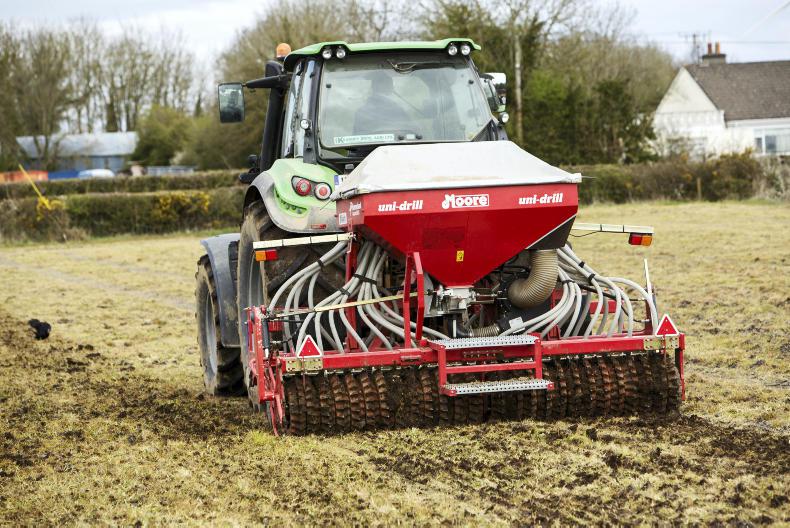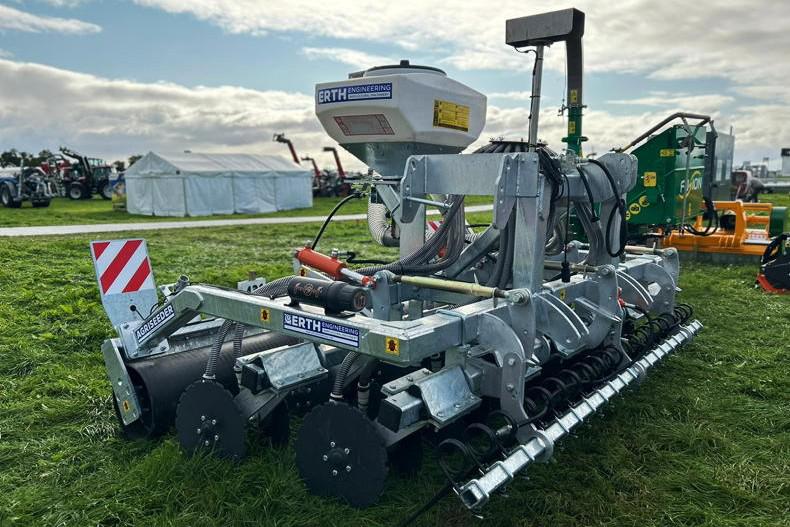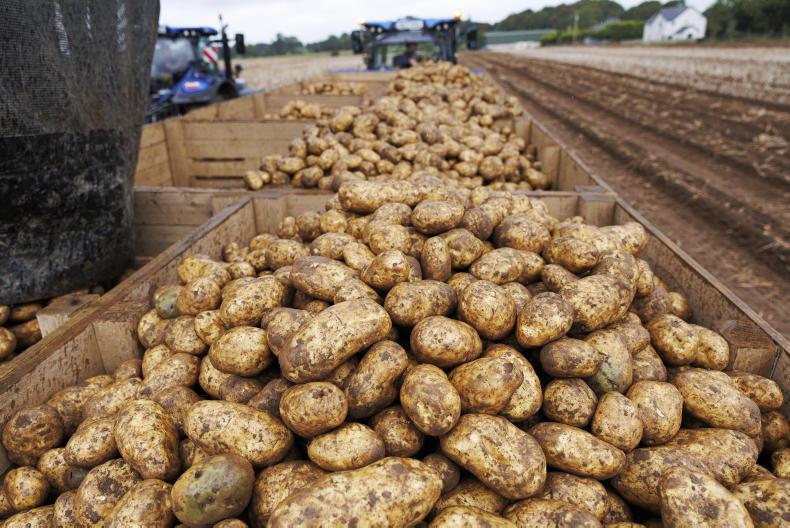Late April and May is an ideal time to take out under-performing grazing paddocks and reseed with new, higher yielding varieties.
Reseeded swards will respond better to early and late season nitrogen, helping to extend the grazing season in the shoulders of the year.
Young swards tend to have faster regrowth once grazed, thereby coming back into the rotation faster.
New varieties
Reseeding grassland with new varieties of ryegrass will also improve animal performance, as grass digestibility, energy and protein levels are generally higher.
Of course, a reseeded sward has to be carefully managed in its first few years.
Under-grazing or under-fertilising a reseed and taking heavy cuts of silage will cause the reseed to fail, allowing weed grasses to re-enter the sward and reduce yield.
Therefore, when reseeding any sward, following the outlined steps will help to successfully establish new grass.
Once a field is identified for reseeding, take soil samples to determine fertility levels. Without addressing poor soil fertility, the growth potential of the new grass will be severely hindered.
Apply lime before ploughing, along with farmyard manure to help condition the soil, as well as getting P and K into the ground.
If grass is being reseeded through minimum tillage methods, burning off the old sward can turn the top few inches of soil acidic, as the dead grass breaks down.
Applying lime after burning off the sward will help to neutralise the soil and improve seed germination.
Once grass seed has been sown, use a compound NPK fertiliser for the first year to help establish plants roots and encourage tillering.
2. Rectify drainage and compaction problems
If grass growth is limited because of poor soil drainage or compaction, then these issues also need to be addressed before reseeding.
Swards that have been heavily poached, or compacted from slurry and silage equipment, need to be opened up through ploughing, sub-soiling or some form or soil aeration.
Sub-soiling should be carried out in dry conditions to increase the cracking effect and is good practice when reseeding through minimum tillage methods.
Drainage is expensive, but often a necessity. Well-drained soils will quickly remove surface water which is keeping soil water-logged and displacing air.
Soils with poor drainage are prone to poaching and compaction and will have lower soil temperatures, limiting grass growth throughout the year.
Once ground has been ploughed and cultivated, grass seed should be drilled into a firm seed bed to avoid being buried too deep and delaying germination.
This is particularly important if clover is included in the mix, as clover seeds are much smaller than grass.
Lighter soils may benefit from rolling after sowing grass seed, but use a light roller to avoid compacting soils.
If grass seed is being drilled into an existing sward, using slug pellets can help to improve grass establishment.
Once the new sward is established, an early application of herbicide is important to eliminate weeds such as chickweed, redshank and docks.
These weeds can compete vigorously for soil nutrients, so a spray will check their growth and allow new grass to push on.
Use a clover-safe spray if the aim is to keep clover in the sward.
5. Graze light and graze often
Once the new grass is established, it is important to encourage tillering to thicken out the sward.
Grazing with light cattle and sheep for the first few grazings is advisable, as they are easier managed than cows, have a lower risk of poaching and can clean the sward out fully.
The key to getting the sward to tiller is to graze covers off quickly and often.
Therefore, carrying a slightly higher stocking density on a reseed will help to clean off covers faster.
Once grazed, move cattle off the sward quickly, apply a compound fertiliser and allow to rest for 18 to 21 days before grazing again.
All reseeds should be grazed in year one to encourage tillering.
Cutting for silage in the first year is not best practice, as it leaves the sward open, allowing weeds to enter.
Read more
Upward feed import trend threatens native producers and product
In pictures: full clearance at Carnew suckler sale
Late April and May is an ideal time to take out under-performing grazing paddocks and reseed with new, higher yielding varieties.
Reseeded swards will respond better to early and late season nitrogen, helping to extend the grazing season in the shoulders of the year.
Young swards tend to have faster regrowth once grazed, thereby coming back into the rotation faster.
New varieties
Reseeding grassland with new varieties of ryegrass will also improve animal performance, as grass digestibility, energy and protein levels are generally higher.
Of course, a reseeded sward has to be carefully managed in its first few years.
Under-grazing or under-fertilising a reseed and taking heavy cuts of silage will cause the reseed to fail, allowing weed grasses to re-enter the sward and reduce yield.
Therefore, when reseeding any sward, following the outlined steps will help to successfully establish new grass.
Once a field is identified for reseeding, take soil samples to determine fertility levels. Without addressing poor soil fertility, the growth potential of the new grass will be severely hindered.
Apply lime before ploughing, along with farmyard manure to help condition the soil, as well as getting P and K into the ground.
If grass is being reseeded through minimum tillage methods, burning off the old sward can turn the top few inches of soil acidic, as the dead grass breaks down.
Applying lime after burning off the sward will help to neutralise the soil and improve seed germination.
Once grass seed has been sown, use a compound NPK fertiliser for the first year to help establish plants roots and encourage tillering.
2. Rectify drainage and compaction problems
If grass growth is limited because of poor soil drainage or compaction, then these issues also need to be addressed before reseeding.
Swards that have been heavily poached, or compacted from slurry and silage equipment, need to be opened up through ploughing, sub-soiling or some form or soil aeration.
Sub-soiling should be carried out in dry conditions to increase the cracking effect and is good practice when reseeding through minimum tillage methods.
Drainage is expensive, but often a necessity. Well-drained soils will quickly remove surface water which is keeping soil water-logged and displacing air.
Soils with poor drainage are prone to poaching and compaction and will have lower soil temperatures, limiting grass growth throughout the year.
Once ground has been ploughed and cultivated, grass seed should be drilled into a firm seed bed to avoid being buried too deep and delaying germination.
This is particularly important if clover is included in the mix, as clover seeds are much smaller than grass.
Lighter soils may benefit from rolling after sowing grass seed, but use a light roller to avoid compacting soils.
If grass seed is being drilled into an existing sward, using slug pellets can help to improve grass establishment.
Once the new sward is established, an early application of herbicide is important to eliminate weeds such as chickweed, redshank and docks.
These weeds can compete vigorously for soil nutrients, so a spray will check their growth and allow new grass to push on.
Use a clover-safe spray if the aim is to keep clover in the sward.
5. Graze light and graze often
Once the new grass is established, it is important to encourage tillering to thicken out the sward.
Grazing with light cattle and sheep for the first few grazings is advisable, as they are easier managed than cows, have a lower risk of poaching and can clean the sward out fully.
The key to getting the sward to tiller is to graze covers off quickly and often.
Therefore, carrying a slightly higher stocking density on a reseed will help to clean off covers faster.
Once grazed, move cattle off the sward quickly, apply a compound fertiliser and allow to rest for 18 to 21 days before grazing again.
All reseeds should be grazed in year one to encourage tillering.
Cutting for silage in the first year is not best practice, as it leaves the sward open, allowing weeds to enter.
Read more
Upward feed import trend threatens native producers and product
In pictures: full clearance at Carnew suckler sale










SHARING OPTIONS